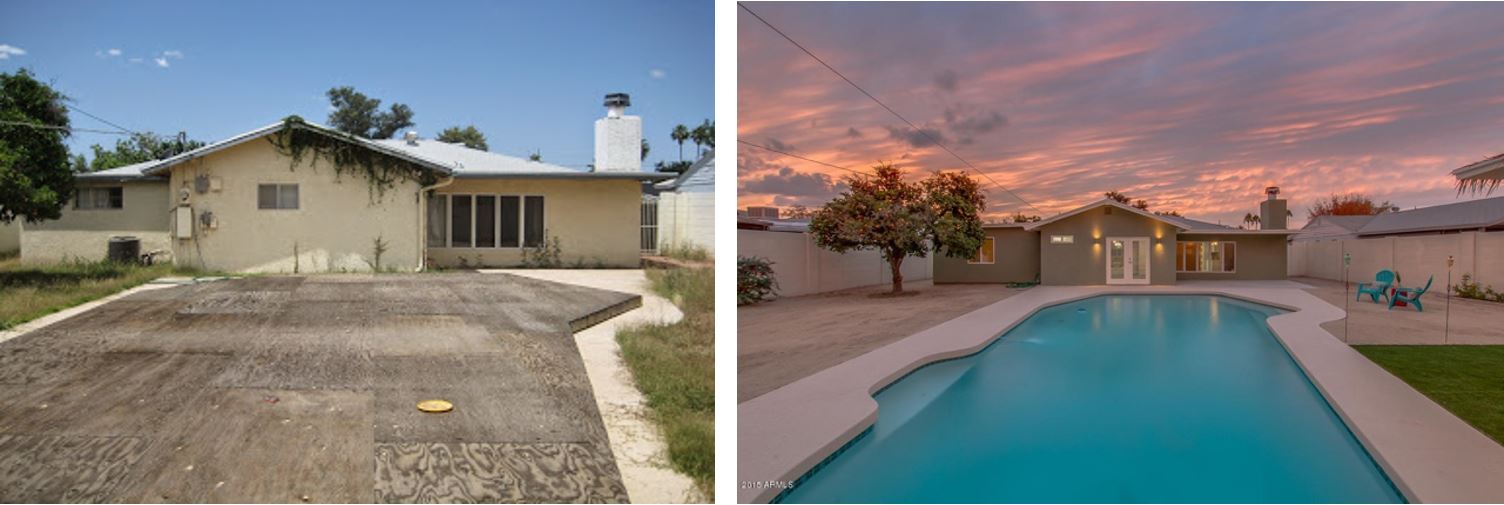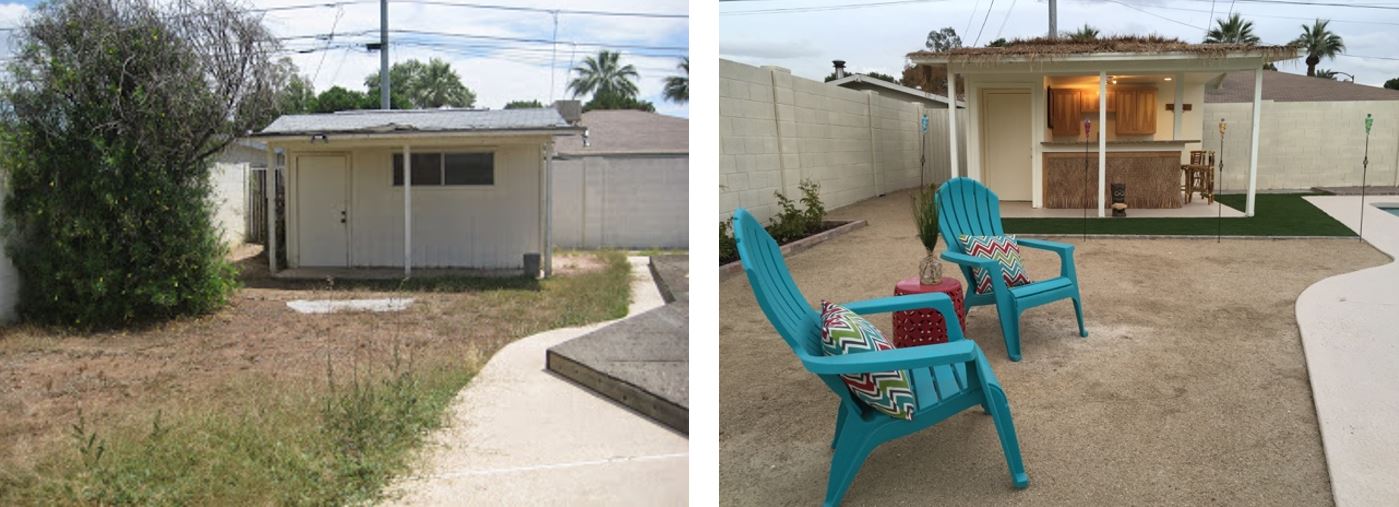Previously, we discussed why it is important to review the various real estate
investing (REI) strategies, and determine which one fits you best in your current
situation.
If you missed it, here’s the link to that article.
We also introduced our proprietary REI Matrix and discussed the wholesaling model,
found here.
This week, we look into the more popular “fix and flip” models.
Fix and Flip Models
Investors who have access to capital, and who want to maximize their cash return over the next 3 – 12 months, favor the “fix and flip” model. This vehicle has become super popular in recent years, in part due to all of the HGTV-type shows that highlight and often glorify it.
For most investors, the asset-of-choice to rehab and sell is an SFR (single-family residence) or a Condo, but some niche investors (including us) fix and flip multi-family properties.
Unlike the “wholesaling” model, where the investor typically doesn’t add much value to the underlying asset that is being sold, the “fix and flip” model is ALL about adding value to the property.
From a ‘feel good’ perspective, fix and flips have always been my favorite model. I really enjoy the feeling I get when I’m the one primarily responsible for taking a tired or neglected property and transforming it into the best one on the block!
It’s awesome to provide great homes to families while forcing appreciation onto the property. Not only does the neighborhood receive an upgrade via a newly remodeled dwelling, but you get to see your vision and hard work pay off as you vastly improve the value of the property, which usually translates to a tidy profit for you.

Before & After pictures of an SFR fix & flip we did years ago. The Pool was boarded up and needed full renovation; & the house had lots of deferred maintenance & needed a significant floor plan revision.
A traditional fix and flip involves buying, remodeling, and selling the property, typically using retail channels for the sale. You don’t need a realtor’s license for the remodeling portion, and you can hire your favorite realtor to sell the property for you once it’s completed. You should expect and plan on paying taxes on your profits at ordinary income (not capital gains) rates.
Here are some indicators of how the “fix and flip” model stacks up, as compared with wholesaling, buy/hold, and other models including traditional realty (realtors):
| Indicator
|
Grade and comments
|
| Speed to $ Proceeds: | Medium
Typically you have to renovate the asset first, which can take months, and then market it on MLS for sale, so total speed to proceeds is often 3 – 9 months; this is slower than Wholesaling but faster than Buy/Hold vehicles.
|
| Capital Required | High
Requires much more capital than Wholesaling; however, this can also be considered a benefit, as it helps weed out competition since many investors cannot pull together the needed capital.
|
| Market Risk | Medium
Because of the time needed to renovate the property, Market Risk is higher than Wholesaling, but lower than Buy/Hold and Entitlement/Land Development vehicles.
|
| Time Intensiveness | High
The Fix/Flip model requires lots of time and management, starting with careful evaluation prior to acquisition, detailed budget and scope of work for the project, coordinating workers/trades, making adjustments in the field as needed, etc. Much of this can be outsourced to a trusted General Contractor or Project Manager, but either way, this is a more time-intensive model than most.
|
| Reward Potential | Very High
This attribute is the primary reason for this model’s popularity. Despite the higher requirements of capital, time, and the medium market risk, the profit potential is enormous. Average profits vary by market, but it is not unusual for a project to deliver profits of $25k to $100k or more per deal.
|
| Typical Annualized ROI | Medium to High
When executed without debt (all cash); this model can provide high profits and medium cash on cash return. When debt (leverage) is utilized, the debt service can drop the profits to a medium level, but since you have less of your cash invested, the cash on cash return can go up to a high level. We often choose to leverage debt on our fix and flips so that the same cash funds can be used to do four or five properties in parallel, instead of one, and Deduct the Total Costs from the Sales Price to estimate your ‘flip’ profit.
|
If you’re investing in your local market, you’ll likely be actively involved in managing the remodeling process – getting quotes for the work to be done, selecting contractors, and so on. If you’re considering investing in fix and flip properties outside of your local market, be sure to align yourself with a team that can do those activities for you, or at least refers you to the people who you will need to succeed.
Let’s now quickly take stock of some of the asset types that investors like to perform the fix and flip model on:
Single Family Residences and Condos
Since there are many more SFRs and condos than there are other types of properties, it’s no wonder why these tend to be the most popular asset types. A steady stream of inventory of these properties is readily available, from wholesalers, realtors/MLS, and websites such as Zillow, Redfin, and Trulia.
Another reason why investors like to fix/flip these asset types is that the exit strategy for these properties is to market it to a wide supply of easy to reach buyers (typically via the MLS) with a large pot of conventional bank financing at their disposal.
That means that the audience of prospective buyers, which will buy your property and thereby lock in your profits, is large, easily defined, easily reached, and have access to ready financing sources.

Before & After pictures of a tool shed that we converted into a Tiki Hut, complete with a wet bar, shower, and thatched grass roof. I love being able to transform boring spaces into cool, useful ones!
2 – 4 Units Multi-Family
Remodeling a duplex, triplex, or four-plex is not much different than renovating a single-family residence or a condo. Often the biggest difference is that each additional unit adds another kitchen, which is usually the most expensive room of the dwelling to remodel. But other than making sure that you adjust your rehab budget accordingly, the process and difficulty factor is about the same.
Once completed, you can still use MLS to effectively market the property to buyers, and there are plenty of buyers that like the idea of living in one unit and having the tenants from the other units cover the mortgage payment for the entire property. In this example, the buyer is owner-occupied and can effectively live there for free, since the other tenants are paying most or all of the mortgage payment.
Whether you sell to an owner-occupied buyer or a passive investor, these 2-4 unit properties can make excellent profits within the fix and flip model. They can be valued based on the comparative sales approach, like SFRs typically are, or can be valued based on what an investor will pay for a stream of cash flow.
This later technique is called the capitalization rate, or “cap rate” approach. If the property is expected to deliver $50,000 a year in net cash (after all direct expenses) and an investor is generally willing to earn a 6.0% return for investing in that kind of property in that area (i.e., based on condition and location of the property), then the value of the property would be approximately $50,000 / 0.06 = $833,333.
Importantly, you should note that traditional residential bank financing is available for 2 – 4 units, just like a single-family residence.
This is huge, as buyers of these properties can take advantage of the excellent financing available, which normally translates into lower down payments needed, and better interest rates.
Conversely, properties with five or more units do not qualify for traditional residential financing and instead are considered commercial properties.
5+ Units Multi-Family
As we just discussed, multi-family properties with 5+ units on the parcel are considered commercial properties and therefore don’t qualify for residential, conventional bank financing. This means that you will need to purchase the property with cash, private (hard) money, or a commercial loan. And you will need to sell it to a buyer that will purchase it using one of the same methods.
Since these are commercial properties, you may be working with commercial brokers, commercial lenders, commercial appraisers, and the terminology that they use, all of which are a bit different than in the residential space.
As these commercial deals are typically larger properties, the planning, renovation, and re-tenanting of these projects will likely take much longer than it does for a single-family remodel.
If the property is mostly occupied with tenants, you will need to coordinate your unit renovations around the tenants or move them out (if they’re month-to-month or the lease is expiring soon), so that you can complete the work safely and efficiently.
Once the renovations are all made, most fix and flip investors in this area will advertise for and place new tenants in the property, normally at higher rates than before, because of the improvements that have been made. Then they will advertise the renovated (and stabilized) property for sale.
Although the capital resources needed for these are often quite high, and the market risk is greater due to the time needed to complete the project, the potential profits at the end of the rainbow can be very lucrative.

Pictures of a 7-plex that we are currently renovating in Phoenix, AZ






